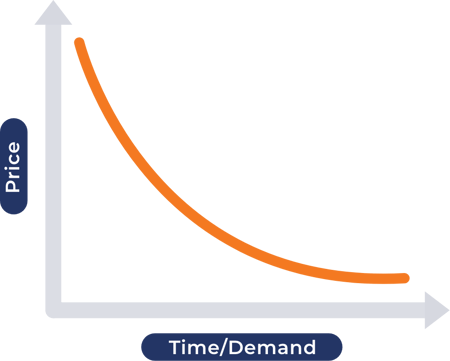Originally published on April 20, 2023, updated April 20, 2023
Menu
Join Our Email List
- Receive our monthly newsletter.
- Stay up to date on Amazon policies.
- Get tips to grow your business.
Developing an effective eCommerce pricing strategy requires careful consideration of various factors that impact pricing decisions. In this article, Seller Snap shares several methods for determining your product pricing.
One of the primary objectives of entrepreneurs entering the eCommerce industry is to achieve business success. Knowing how to strategically set product prices can help position your online business for greater success and growth. To help you attain this goal, you need to get acquainted with the various pricing strategies in eCommerce.
It is important to note that pricing your products too low can negatively affect your sales and cash flow. Conversely, setting a price point that is too high may result in lower sales volumes, leading to decreased profits due to increased overhead costs per unit as you sell fewer items.
In this article, we will cover the fundamental principles of product pricing and explore various pricing strategies commonly used by online businesses.
An eCommerce pricing strategy is a systematic pricing approach online sellers and retailers use to price their products on different eCommerce platforms. It involves developing and selecting the most appropriate product price to increase sales and revenue while remaining competitive in the market.
Since each business is unique, each may have its own pricing strategy. When planning and implementing an eCommerce pricing strategy, there are several factors to consider, including your:
If your online business is making money right now, it is still worth examining your pricing strategy to see if there are ways to increase profits. Here are a few examples of pricing strategies you can use now and in the future.
The underlying concept of this pricing technique involves determining the totality of fixed and variable expenses during the production process. The seller then adds a percentage markup to these expenses to arrive at an approximate selling price.
The formula for cost-plus pricing is:

For instance, if the cost of producing a product is $50 and the markup percentage is 25%, the selling price would be:
Cost ($50) x (1 + 25%) = Selling Price ($62.5)
The simplicity of the cost-plus pricing strategy is its primary benefit, as it involves only adding a markup percentage to the production cost, making it easy to calculate.
However, this pricing approach does not consider market demand or consumer behavior. It assumes that customers will accept the markup regardless of whether the price is fair or competitive, which may lead to low sales performance.
The use of a cost-plus pricing strategy depends on the type of business you have. If your product's value is mainly determined by its production cost, then using markup is a reasonable method to increase profits.
If the value of your product is based on other factors, such as customer demand or competition, you may need to adopt a different pricing strategy that can quickly adapt to changes in the market.
Wondering how to price a product on Amazon? If your business operates in a competitive market like Amazon, you should consider using competition-based pricing as an eCommerce pricing strategy. Unlike cost-plus pricing, this method emphasizes external factors like market conditions rather than internal factors such as production costs.
 To implement this strategy, you must first identify your competitors in the market and analyze their pricing and positioning strategies. You should then calculate the average price of your product type across competitors to establish a benchmark price to compare your product's rates.
To implement this strategy, you must first identify your competitors in the market and analyze their pricing and positioning strategies. You should then calculate the average price of your product type across competitors to establish a benchmark price to compare your product's rates.
After researching your competitors' price points, you can decide whether to price your product higher, lower, or at the same level as your competitors in the marketplace.
The main advantage of competition-based pricing is its simplicity in both computation and execution. By studying your market competitors and determining the average price, you can easily decide whether to price your product lower, higher, or the same as your competitors.
However, this pricing approach can be limiting in the sense that it can prevent you from establishing a connection between your product's value and the price it commands. Solely focusing on competitors' prices may lead to missed opportunities to differentiate your product in ways that justify a higher price point.
Adopting a competition-based pricing strategy can benefit online sellers or retailers operating in a highly competitive marketplace. Also, sellers selling similar products as their competitors can benefit from this pricing method.
However, this pricing strategy may not be the best approach for businesses with unique or highly differentiated products that provide significant value to customers beyond price.
Value-based pricing is a method that considers customers' perceived product value. It considers customer needs and expectations by setting prices based on what they are willing to pay for a product.
If you wish to implement this pricing technique, you need to recognize that it requires a deep understanding of customers and what they consider valuable.
You will need to do ample market research to identify customer needs, preferences, and willingness to pay. You should consider the benefits your product offers relative to the alternatives available in the market.
With value-based pricing, businesses can charge higher prices for their products based on the perceived value that customers place on them. This approach is beneficial because it can help easily attract customers willing to pay more for products that provide excellent value and better customer service.
However, implementing value-based pricing can be challenging as it requires significant investment in collecting customer data to understand what they value in a product. Moreover, perceptions of value can shift over time, making it necessary to continually update the product’s features to keep it valuable.
Value-based pricing can be a potent pricing strategy for eCommerce businesses that sell products that offer unique features and provide significant value to customers. This pricing approach is convenient for businesses targeting customers who prioritize quality, convenience, and other benefits beyond price.
 Price skimming, also referred to as skim pricing, is a pricing strategy that involves setting high prices for a product at its launch, followed by a gradual decrease over time to attract more price-sensitive customers. This approach takes advantage of the initial hype surrounding a product's introduction to the market.
Price skimming, also referred to as skim pricing, is a pricing strategy that involves setting high prices for a product at its launch, followed by a gradual decrease over time to attract more price-sensitive customers. This approach takes advantage of the initial hype surrounding a product's introduction to the market.
Price skimming can generate higher initial sales figures, which can help to recoup research and development costs. Additionally, if the interest in the product can be sustained for a more extended period, it can result in a better return on investment (ROI).
However, this pricing strategy is only effective if the demand curve for the product is relatively inelastic, meaning that price changes do not significantly affect demand. If price skimming efforts are unsuccessful, there is a risk of ending up with excess inventory.
The skim pricing strategy is best suited for eCommerce businesses that face little to no competition. This strategy can be especially beneficial for companies introducing a new product to the market. However, it is important to note that this strategy should only be implemented if the product is genuinely innovative and unique.
Dynamic pricing is a method that assesses current market factors, such as demand and competition when setting product prices. Since this pricing strategy necessitates quick price adjustments in response to the market condition, such adjustments are made in real-time to optimize revenue and profit margins.
To facilitate such a requirement, online sellers make use of repricing software. A repricer enables you to implement dynamic pricing strategies more effectively and efficiently.
By automating the price adjustment process, you can quickly respond to market changes and make real-time pricing decisions based on data analysis. Sophisticated repricers, such as AI repricers, are the best tools to help you implement a dynamic pricing strategy.
Employing dynamic pricing for your eCommerce business can provide multiple benefits, such as swiftly modifying your prices in response to real-time market conditions, leading to increased sales and profits. Moreover, dynamic pricing allows for adjustments to product prices during periods of reduced market demand, enhancing inventory turnover.
However, like other pricing strategies, dynamic pricing has some drawbacks. One potential disadvantage is the risk of price wars that can negatively impact your profit margins. For that matter, intelligent repricing software is essential to mitigate, if not avoid, instances of price wars.
Businesses that sell products with varying demand and supply levels can benefit from dynamic pricing strategies. Such pricing strategies benefit eCommerce businesses seeking to maximize their revenue and profits by modifying prices in real-time in response to market fluctuations.
Understanding the underlying concepts of pricing strategies can help you select a strategy that aligns with the prevailing market conditions. However, the crucial factor to consider is ensuring that your pricing strategy likewise aligns with your business objectives.
In addition, it is essential to recognize that having a pricing strategy alone does not guarantee success. Your pricing strategy should align with other elements of the business, such as marketing, customer service, customer feedback management, and product research in order to achieve the desired results.
Originally published on April 20, 2023, updated April 20, 2023
This post is accurate as of the date of publication. Some features and information may have changed due to product updates or Amazon policy changes.
These Stories on Business
14321 Winter Breeze Drive
Suite 121 Midlothian, VA 23113
Call us: 800-757-6840





Copyright© 2007-2025 eComEngine, LLC. All Rights Reserved. eComEngine®, FeedbackFive®, RestockPro®, and SellerPulse® are trademarks or registered trademarks of eComEngine, LLC. Amazon's trademark is used under license from Amazon.com, Inc. or its affiliates.
No Comments Yet
Let us know what you think